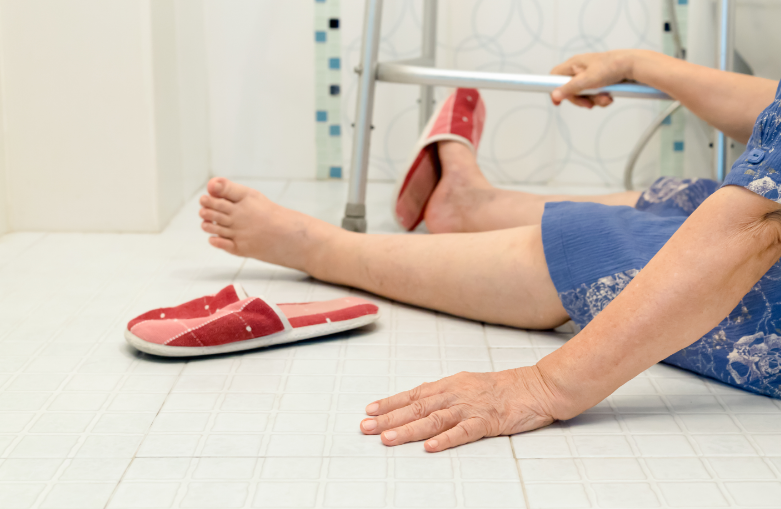Each year, 36 million people in the US aged 65+ report a fall; three million visits the emergency room. Falling doubles the likelihood of future falls and kills 600 people every day.
Falling is usually the result of many factors, including medical conditions, medications, and environmental factors.
Today we’ll learn about the dangers of falling, risk factors, and fall prevention tips for elderly people.
Risk Factors for Falling
- Increasing age
- Vision issues
- Balance problems
- Certain medications
- Vitamin D deficiency decreases bone density and strength
- Postural problems
- Tripping hazards
- Poor footwear
- Foot pain
- Previous falls
- Slippery surfaces and clutter
- Poor lighting
- Lack of assistive devices
Why is Falling So Dangerous?
Bad falls can cause:
- Broken bones and fractures
- Sprains
- Joint dislocation
- Bad cuts
- Head injuries
- Fear of falling again. This may lead to a reduction in activity and fitness levels, which can lead to falling.
Injuries may limit mobility and make completing daily tasks difficult. This is particularly true for hip fractures, 95% of which are caused by falling. About half of people who fracture their hip will not regain full independence.
Women are at a higher risk, as bone density decreases after menopause. However, anyone can fracture their hip.
Complications of a hip fracture, especially if they limit mobility, incl:
- Blood clots
- Urinary tract infections
- Bedsores
- Pneumonia
- Loss of muscle mass, which increases the risk of future falls and injuries
- Infection
- Death from a combination of the above and pre-existing conditions
Falling is also the number one cause of traumatic brain injury (TBI) for older adults. A significant TBI can lead to:
- Unconsciousness
- Memory and thinking difficulties
- Loss of balance and coordination
- Vision and hearing problems
- Risk of developing dementia
- Bleeding in the brain for those taking blood-thinning medications
Fall Prevention Tips
1. Talk to a Healthcare Provider
Because the risks associated with falling are so severe, the wisest first step is to speak with a professional. We should talk about:
- Medications and supplements. Our healthcare provider can review our medications and how they interact. This helps them determine if they’ll increase our risk of falling and adjust them accordingly.
- Pre-existing health conditions. This helps our healthcare provider understand other factors that may lead to falling, like muscle problems, dizziness, and pain. They can also look at how we walk and check our muscle strength.
- Eye and ear health. It’s important that we get our eyes and ears checked regularly, as issues with either one can cause falls.
2. Stay Active
After getting medical clearance, we should try to stay active. Physical activity builds strength, balance, flexibility, and coordination, which helps prevent falls. We can choose exercises based on our abilities and fitness level, like:
- Walking
- Jogging
- Swimming
- Dancing
- Tai Chi
- Yoga
- Resistance band workouts
- Bodyweight exercises
3. Remove Tripping and Slipping Hazards
Many falls happen at home. To reduce this risk, we should:
- Clear walkways and high-traffic areas of electrical cables, boxes, furniture, etc.
- Tape down loose rugs
- Get non-slip mats for slick surfaces like the shower, bathroom, and kitchen
- Wear sturdy, non-slip slippers/house shoes
- Clean up spills on hard flooring surfaces immediately
4. Use Assistive Devices
We may avoid using assistive devices in service of our pride. But it’s helpful to remember that assistive devices help us maintain independence and interact with our environment in a safer way. We may consider devices like:
- Grab bars, which can be installed in the shower and over the toilet
- Handrails for both sides of the stairs
- Canes and walkers
- A shower seat
- A stairlift
- A raised toilet seat
Although not an assistive device, hip pads may also provide protection in the event of a fall.
Additional Tips
- Make sure homes are well-lit. Use nightlights, ensure lamps, and light switches are accessible and replace burnt-out lightbulbs immediately.
- Stand up slowly, as getting up too fast can cause dizziness
- Be extra careful on icy, oily, and wet surfaces
- Limit alcohol intake
- Get enough sleep
Summary
Falls are the leading cause of fatal and non-fatal injuries for people over 65. They can cause serious medical problems and can limit our physical and cognitive abilities. But there are many steps we can take to prevent falls. Speak with a medical practitioner, stay active, remove environmental hazards, and use assistive devices when needed.
Sources:
https://www.cdc.gov/falls/facts.html
https://www.cdc.gov/falls/hip-fractures.html
https://www.ncbi.nlm.nih.gov/books/NBK235613/
https://www.mayoclinic.org/diseases-conditions/hip-fracture/symptoms-causes/syc-20373468
https://www.ncbi.nlm.nih.gov/pmc/articles/PMC2367127/
https://www.alz.org/alzheimers-dementia/what-is-dementia/related_conditions/traumatic-brain-injury
https://www.mayoclinic.org/healthy-lifestyle/healthy-aging/in-depth/fall-prevention/art-20047358

